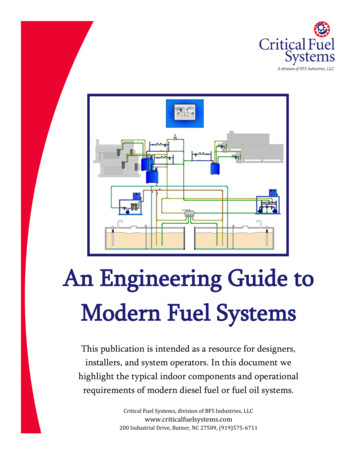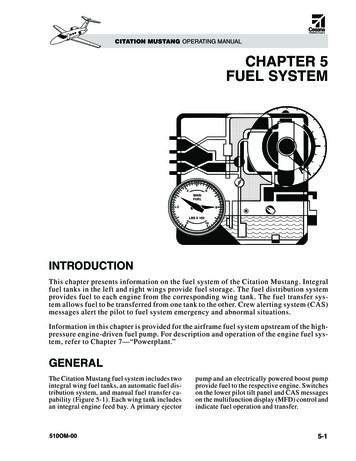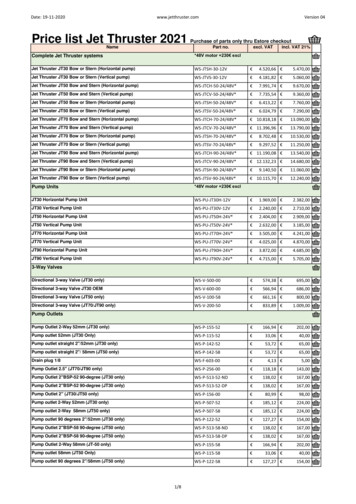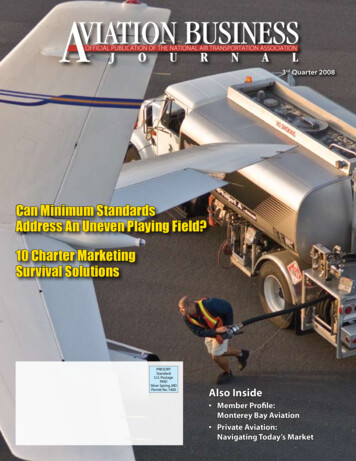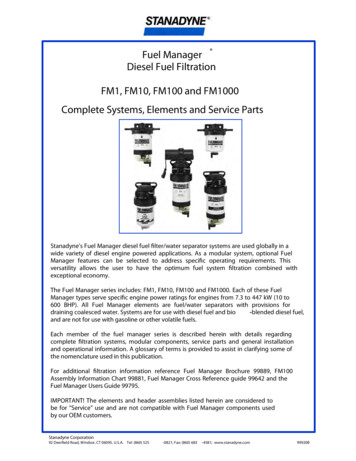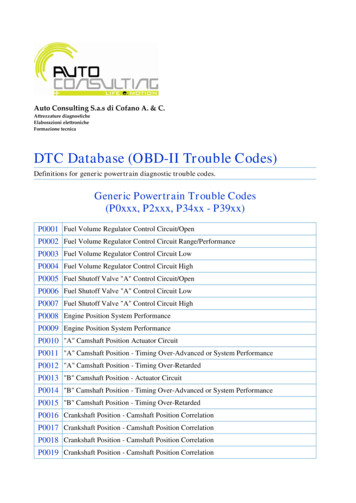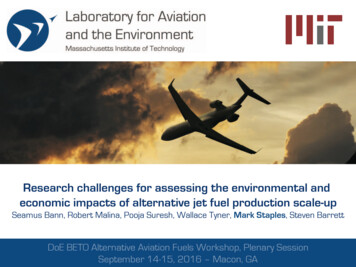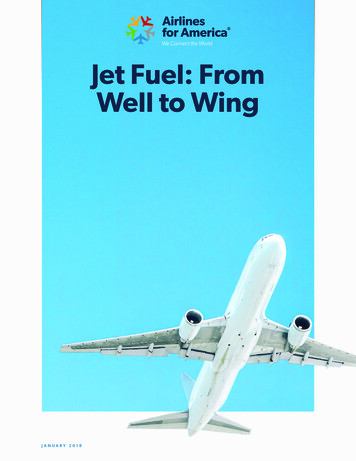
Transcription
Jet Fuel: FromWell to WingJANUARY 2018
AbstractAirlines for America (A4A) is the nation’s oldest and largest U.S. airline industry trade association. Its members1 and theiraffiliates account for more than 70 percent of the passenger and cargo traffic carried by U.S. airlines. According to theEnergy Information Administration, U.S.-based jet fuel demand averaged 1.6 million barrels per day in 2016. Generally, fuelis supplied to airports through a combination of interstate multiproduct pipelines, third-party and off-airport terminals, anddedicated local pipelines. The last few years have continued to demonstrate the fragility of this complex system and thethreat it poses to air-service continuity.The current interstate refined products pipeline system, constructed many decades ago, is both capacity-constrainedand vulnerable to disruptions that typically require a patchwork of costly, inadequate fixes. New shippers have difficultyobtaining line space and long-established shippers have difficulty shipping all of their requirements. It is likely that demandwill continue to outpace the capacity of our outdated distribution system for liquid fuels.Given the increasing demand to transport liquid fuels, it is imperative that we take steps to overcome existing bottlenecksand prevent future ones. These fuels are essential to aviation, trucking and rail, among others, which help power our twentyfirst century economy. As shippers and consumers of significant quantities of refined products on pipelines throughout thecountry, airlines and other users of liquid fuels have a substantial interest in addressing the nationwide deficiency in pipelineinvestment.Surely, expedited permitting for fuel distribution-related infrastructure projects could help pave theway to upgrade existing pipeline assets and expand throughput capacity into key markets. But thisdeficiency is largely tied to a ratemaking system that lacks both transparency and effective regulatoryoversight, resulting in a lack of incentives for pipelines to upgrade or expand their existing networks.Accordingly, A4A calls on the Federal Energy Regulatory Commission(FERC) to increase the transparency of pipeline data submissions,strengthen oversight of over-recoveries and excessive returns andrecognize fuel shippers and consumers as key constituents.1 Alaska Airlines, Inc.; American Airlines Group Inc.; Atlas Air, Inc.; Federal Express Corporation; Hawaiian Airlines; JetBlue Airways Corp.; Southwest Airlines Co.; United Continental Holdings, Inc.; andUnited Parcel Service Co. Air Canada is an associate member.
3ContentsI. Introduction Jet Fuel Pricing Refining and Distribution Fuel Efficiency and Environmental PerformanceII. Fuel Supply Risk Primary Types of Supply-Chain Risk Operational Remedies Pipeline Capacity ConstraintsIII. Pipeline Economic Oversight Increase Transparency of Pipeline Data Submissions to FERC Strengthen Oversight of Over-recoveries and Excessive Returns Recognize Fuel Shippers and Consumers as Key ConstituentsIV. ConclusionAppendix A. Economic Oversight of Pipelines and Ratemaking MethodologyAppendix B. Case Studies in Pipeline Regulation and Infrastructure Development The Wrong Incentives Are in Place Excessive Returns on Existing Capital Base Discourage Investment Critical Infrastructure Has Been Carved Out From FERC Oversight Addressing Excessive Recoveries Encourages Investment
4IntroductionIn 2016, U.S. passenger and cargo airlines consumed more than 19 billion gallons of jet fuel, poweringsome 27,000 daily flights carrying 2.2 million passengers and 50,000 tons of cargo acrosshundreds of airports worldwide. Globally, airlines consumed 81 billion gallons of jet fuel.2 Accordingto the Energy Information Administration, U.S.-based jet fuel demand averaged 1.6 million barrels perday in 2016.3Jet Fuel PricingThe price of jet fuel is linked to the commodities marketsAir carriers buy fuel from multiple suppliers at differingprincipally through ultra-low sulfur diesel (ULSD), arates and in different locations. Not every supplierrefined product that is similar in consistency and tradedoperates at every domestic airport that a carrier mayon public exchanges. The price of ULSD is highlyserve, so multiple arrangements are necessary, includingcorrelated to the price of jet fuel and therefore is oftentransporting fuel from a market center to the airport.used as a reference point for supply contracts. In additionto the ULSD market, other factors impacting the priceHistorically, the price of jet fuel has been very volatile,of jet fuel may include: inventory levels; transportationand due to the airline industry’s dependence on fuel,costs; refinery dynamics; environmental regulations;the industry is particularly susceptible to fuel price risk.surges in regional demand; seasonality; and supplyAn airline may choose to hedge a portion of its jet fueldisruptions caused by natural disasters, military conflictrequirements to mitigate financial uncertainty caused byor geopolitical events.pricing volatility.4Just as motorists pay different prices for gasoline indifferent parts of the country, airlines pay different pricesregionally for jet fuel. Generally the Gulf Coast has thelowest prices in the country as the region produces morethan it needs. Other areas trade at a premium that mostlyrepresents the transportation costs from the Gulf Coast.However, the premium in some regions is higher thanthis as pipelines don’t exist or do not have adequatecapacity to meet demand. Although the United Stateshas become a net exporter of jet fuel, the West Coast,Florida, and the northeast typically require imports dueto expensive domestic freight options.2 ndustry-performance.aspx3 n PET&s MKJUPUS2&f M4 Hedging requires a willing counterparty and, at times, a sizable upfront transaction cost. An airline also must consider whether it could find itself at a competitive disadvantage if its competitors have nothedged and the energy market price drops below what it has agreed to pay in a hedge contract.
5Refining and DistributionAt the refinery, crude oil is separated into usable petroleum products, including gasoline, distillates such as diesel andjet fuel, petrochemical feedstocks, waxes, lubricating oils and asphalt. Jet fuel represents less than 10 percent of U.S.refinery yield, but could be as much as 25 percent at a specific refinery depending on its configuration and source offeedstock.5 Specifically, commercial aviation turbine fuel used in the United States is a kerosene-based product meetingthe requirements of the applicable ASTM International specification (e.g., composition, volatility, fluidity, combustion,corrosion, thermal stability, contaminants, additives).6PRODUCTS MADE FROM A BARREL OFCRUDE OIL IN THE UNITED STATES, 2016Note: A 42-gallon (U.S.) barrel of crude oil yields about 45 gallons of petroleum products because of refinery processing gain.Source: U.S. Energy Information Administration5 https://www.eia.gov/Energyexplained/index.cfm?page oil refining6 https://www.astm.org/Standards/D1655.htm; other standards may apply outside the United States
6From the refinery, jet fuel typically travels by pipeline or oceangoing vessel to storage terminals, from which it is furthertransported by truck, barge or pipeline to airports. From the airport storage tanks, fuel is distributed to aircraft via truck orvia an underground hydrant system that carries fuel to the airport apron, where hoses span the final distance to the wing ofthe airplane.JET FUEL SUPPLY CHAIN
7MAJOR U.S. REFINED PRODUCTSPIPELINES CARRYING JET FUELWith demand to transport refined products such as gasoline, diesel and jet fuel on the rise,steps must be taken to avoid bottlenecks. These fuels are essential to aviation, trucking and rail,among others, which help power our twenty-first century economy. Expedited permitting and/or a streamlined approval process for related infrastructure projects could help pave the way toupgrade existing pipeline assets and expand throughput capacity into key markets.
8Fuel Efficiency and Environmental PerformanceSimply put, environmental excellence and sustainabilityThe most recent data available from the U.S.are a vital part of the airlines’ business model. Even as theEnvironmental Protection Agency (EPA) shows that lessnumber of passengers has tripled since the mid-1970s,than 2 percent of domestic greenhouse gas (“GHG”)emissions is attributable to commercial aviation and theU.S. airlines have improved fuel efficiency bysector exhibits much lower growth from 1990 levels (8120%percent) — and from a much smaller base — comparedto the transportation sector (16 percent) and on-roadsources in particular (23 percent).8and reduced aircraft noise exposure ganization’s Committee on Aviation EnvironmentalProtection, A4A and its member airlines continue tosupport the development of economically reasonable,They have achieved this level of environmentaltechnologically feasible international aircraft-and-engineperformance by relentlessly pursuing and implementingstandards governing noise, oxides of nitrogen (NOx),technological, operational and infrastructure-relatedparticulate matter (PM) and carbon dioxide (CO2).measures to minimize environmental impacts.With the price of jet fuel significantly impacting routeAs a result of the successive, increasingly stringent NOxprofitability, airlines constantly strive to improve jet fuelstandards, aircraft engines produced today must be aboutefficiency. Fuel conservation measures include reducingand more accurately measuring onboard weight,cruising longer at higher altitudes, employing greateruse of flight-management systems, and conducting morein-depth analyses of weather conditions. In addition,airlines are modernizing their fleets and investing indrag-reducing winglets.7 Use of twenty-first rthan under the initial standard adopted in 1997.directaircraft, across the globe, is also a critical means ofminimizing fuel burn for airline flight operations.7 https://en.wikipedia.org/wiki/Wingtip device, s.html8 Domestic transportation only, from “Inventory of U.S. Greenhouse Gas Emissions and Sinks: 1990-2015,” Table A-116, U.S. Environmental Protection Agency
9Fuel Supply RiskGiven the 24/7 nature of flight operations, the continuity of air service is highly dependent on anuninterrupted supply of on-time, on-specification jet fuel at large, medium and small airports around theworld. Passengers and shippers depend on our industry for global connectivity, and the airlines in turndepend on a fragile supply chain.Primary Types of Supply-Chain RiskAirports may experience disruptions on-airport and off-airport. While an on-airport disruption can have an immediateimpact because it may prevent the airlines from accessing their stored fuel, the exposure is low since most issues can becontrolled. The primary off-airport threats to fuel supply are 1) loss of use of a fuel terminal or pipeline that feeds the airportand 2) systemic unavailability of fuel caused by the catastrophic loss of refining capacity as a result of natural disasters orgeopolitical shocks.PHYSICAL CONSTRAINTSTHIRD-PARTY ARRANGEMENTSThe last few years have continued to demonstrate theAdditionally, bulk fuel supplies can be sourced fromfragility of this complex system and the threat it poses tointermediary fuel purchasers or directly from refiners.air-service continuity. For example, pipeline explosionsIntermediary fuel suppliers purchase fuel from refinerscaused stoppages that threatened to shut down airportsand can be responsible for the transport of fuel to thethat were dangerously close to running out of fuel.airport where it is then purchased by the airline. TheseAnother fuel supply chain risk involves product terminals,third-party arrangements eliminate the airline’s burdenwhere scarcity of storage often leads to cancellation ofto secure transportation and quality control of the fuel.fuel shipments – placing airports in a precarious fuelHowever, the lack of direct control of the supply chainshortage situation.often leaves the airlines in the dark when disruptionsoccur.To mitigate the risk of supply chain disruptions,whenever practicable, many airlines source fuel directlyfrom the refinery, take title of the fuel at the refinery gateand ship it to where it is needed, therefore omitting thirdparties. Having direct access to capacity on pipelinesis an important fuel-disruption mitigation strategy; forexample, if a pipeline goes off-line, the airline receivesdirect notification of a potential problem, allowing thelongest possible time to react. However, this can also beexpensive since all costs to redirect the fuel are typicallyborne by the shipping airline.
10Operational Remediesdisrupted,Trucks are another mode of delivering fuel to airports;alternative means of transporting jet fuel tohowever, the relatively small volumes a truck can carryairports are generally inadequate. Oceangoingrequire an unreasonably large number of trucks to supplyvessels or barges have finite capacity and requiremajor airports. There are neither enough fuel trucksairports to be located near a waterway. Additionally,to supply the needed volumes of fuel to U.S. airportsthe Jones Act requires that those vessels be U.S.-built,nor capacity at airports to unload them. Finally, there-owned and -operated to ship fuel within the Unitedis transportation by rail; while rail can offer sufficientStates, further limiting the volume of fuel that can bevolumes, the U.S. rail infrastructure and the available railtransported over the water, and are dependent oncars for transporting jet fuel are not sufficient to meet theterminals that cannot easily handle additional volumesairline industry need. In short, operational remedies areof jet fuel on short notice unless already serving the jetextremely limited and costly.Whenpipelineoperationsare9market.In the event of an off-airport fuel disruption, the airline industry responds quickly to ensure minimal impact on flightoperations. Impacted suppliers and airlines will first seek alternate supply. If alternate supply cannot be acquired, eachairline serving the affected airport would have to consider the following options:TankeringTechnical StopsSchedule ReductionsCarrying extra fuel oninbound aircraft to reducethe amount needed at theaffected airportStopping at an intermediateairport to refuelCanceling flights andrerouting passengersthrough other airportsTankering can be a very effective means of supplementing inventory and alternative supplies. However, it is expensive andenvironmentally inefficient to carry more fuel than otherwise needed to reach the destination. Accordingly, airlines strive toavoid operational tankering whenever possible.9 See http://www.maritimelawcenter.com/html/the jones act.html and tic-shipping/
11Pipeline Capacity ConstraintsAs indicated above, the airline industry — and theJet-fuel demand in the United States — driven by U.S. andair travelers and shippers who rely on it — is heavilyforeign airlines, business aviation and military aviationdependent on interstate pipelines to deliver jet fuel for— has grown substantially over the past few decades.daily operations. Ensuring a reliable supply of jet fuelAlthough significant fuel-efficiency gains slowed theat the nation’s commercial airports is a critical elementrate of consumption growth from 2000 to 2016, theof reliable, cost-effective flight operations and isunderlying economic demand for air travel and shippinginextricably tied to the logistics and costs of transportinghave boosted daily U.S. jet-fuel demand to a level morejet fuel across pipelines.than double what it was just four decades earlier, whenmultiproduct pipelines were relatively new on the scene.Daily Jet Fuel Consumption in the United States10The vast majority of this fuel is disseminated to airports viaThe Federal Aviation Administrationpipeline, but many major pipelines are already shippingexpects passenger traffic to growthe maximum amount of fuel that their system’s physicalconstraints allow. Today, new shippers can have difficultyobtaining line space and long-established shippers havedifficulty shipping all of their requirements.2.5%annually over the next 20 years andcargo traffic to grow2.8%annually.11It is thus quite likely that demand will continue to outpacethe capacity of our outdated pipeline distribution system.10 https://www.eia.gov/dnav/pet/pet cons psup dc nus mbblpd a.htm and nnualproj11 https://www.faa.gov/data research/aviation/
12The current interstate pipeline system, constructed many decades ago, cannot meet current demand and is vulnerable todisruptions. Following are selected issues across the country:MID-CONTINENTWEST COAST Explorer Pipeline is at full capacity north of Tulsa, Kinder Morgan Pipeline to San Francisco is limitedOklahoma, most months at all destinations exceptto existing infrastructure under San Francisco Bay;Wood River, Illinois; Explorer chooses to allow jet fuelinstalling a new pipe is essential to future growth atshipments only every other cyclethe airport Badger Pipeline to Chicago has been at full capacitymost months except winter Buckeye Pipeline has been at full capacity everymonth to Indianapolis and Pittsburgh Olympic Pipeline is at full capacity; to Portland,Seattle and Vancouver Kinder Morgan Pipeline capacity to San Diego isbarely adequate for current needs, restricting futuregrowth; although the pipeline could alter the delivery Enterprise Pipeline stopped shipping jet fuel toChicagoschedule, they choose not to due to concerns forother shippersEAST COAST Shippers in Phoenix are often limited, seemingly atrandom, with respect to the amount of jet fuel they Plantation Pipeline is at full capacity to thecan send via pipelineWashington, DC area, forcing some users to buy halftheir volume from resellers and opportunistic sellersexploiting the market Colonial Pipeline’s main line and several spur lines areat full capacity Buckeye Pipeline to New York City airports isperiodically at full capacityPipelineEconomicOversightPer the Interstate Commerce Act (ICA),12 as natural Florida is disconnected from U.S. pipelinemonopolies,13 interstate pipelines are regulated byinfrastructure and wholly reliant on waterborne importsthe Federal Energy Regulatory Commission (“theCommission” or FERC), which in turn has a statutoryresponsibility to ensure that rates are “just andreasonable.”14 As shippers and consumers of significantquantities of jet fuel on pipelines throughout thecountry, airlines have a substantial interest in ensuringthat pipeline tariffs are derived and maintained on a justand reasonable basis and in a manner that is not undulydiscriminatory or preferential.
13Moving jet fuel from the Gulf Coast to the Midwest costsaddressed the “over-recoveries” that exist under anearly 2.50 per barrel, a 72 percent increase overstructure that has been in place for more than twothe past 10 years. Even before the products are moveddecades.on those pipelines there are costs associated with themovement of crude oil to the refineries – a cost passed-It is in the interest of all consumers of liquid fuels —on to end users.including the flying, driving and shipping public —for the Commission to increase the transparency ofThe pipeline industry has consolidated substantially sincepipeline filings, tariffs and rate-making processes. Such1995 when the Commission began allowing automatictransparency is especially critical within a regulatoryindex-based rate increases and market-based rates,framework that relies almost exclusively on the shippersbut there has been no systematic review of individualto police pipeline rates and initiate administrative actionscarrier rates and costs. Meanwhile, the cumulative indexto ensure that rates and services are provided on a justincrease from 1995 to 2017 exceeded 80 percent.and reasonable basis. But consumers of gasoline, diesel,During this period pipelines have consistently reportedpropane and home heating oil, for example, typicallyexcessive returns on existing assets. A4A considers alack the resources to monitor and contest pipeline ratespipeline company’s annual return to be “excessive”and services, so airlines are in the forefront of policingor reflecting an “over-recovery” when it reports to thethem.Commission total interstate operating revenues greaterthan total cost of service (which cost of service alreadyFurther, the pipeline’s routine excess recoveries distortincludes an allowed return). To address this issue, if anymarket forces and create barriers — not incentives — topipeline has an “excessive” return or an “over-recovery”needed infrastructure investment. Additional and moreexceeding 7.5 percent for two consecutive years, thetransparent information will enable effective regulation ofCommission should require the company to show causethe nation’s interstate pipelines and promote investmentas to why its rates are just and reasonable.in the infrastructure required to support a thriving,15efficient pipeline industry and a thriving, affordablePerversely, because the current regulatory framework —commercial aviation system. For more detail on pipelinenow in place for more than two decades — effectivelyregulatory issues, see Appendix A.allows pipeline owners to systematically charge rates thatover-recover costs on existing assets, they have little,Congress and or/federal agencies could take theif any, incentive to invest in expansion and/or upgradefollowing steps to improve the reliability of our nation’sof existing interstate pipeline networks. The pipelinejet-fuel supply: establish incentives to increase refinedperspective is that such projects or investments diluteproduct pipeline capacity, increase the transparency ofthe return from existing pipeline assets, making newpipeline data submissions to regulators, and increaseinvestments comparatively unattractive. This is anotheroversight of pipeline over-recoveries and excessivereason why a systematic review of pipeline rates andreturns.costs and a show cause process are needed. Thesedisincentives would be eliminated if the Commission12 See ICA sections 1(4) and 1(5) and books/volume-III/8.pdf13 Per “Regulation of Natural Monopoly” (Ben W.F. Depoorter, Center for Advanced Studies in Law and Economics, University of Ghent, Faculty of Law): “Under perfect competition prices of goods equalmarginal cost, as firms engage in a competitive bidding process. Under conditions of monopoly, the profit-maximizing behavior of the incumbent firm will lead to a higher price charged to consumers and alower output. It enables the seller to capture much of the value that would otherwise be attained by consumers. Monopoly pricing thus results in a wealth transfer from consumers of a product to the seller.”14 Ibid. “Allowing regulated firms to acquire a total sum that consist of annual expenditure plus a reasonable profit on capital investment, the so-called ‘fair’ rate of return, was constructed by Americancourts and the regulating bodies in order to meet constitutional demands of utilities to set prices on a ‘just and reasonable’ level.”15 See Joint comments of Airlines for America, National Propane Gas Association and Valero Marketing and Supply Company and Affidavit of Daniel S. Arthur, Principal of The Brattle Group, Docket No.RM17-1-000, “Revisions to Indexing Policies and Page 700 of FERC Form No. 6” (Jan. 19, 2017)
14
15Increase the Transparency of Pipeline Data Submissions to FERCAs noted above, under the ICA the Commission is responsible for regulating the rates, terms and conditionsthat oil pipelines charge for interstate transportation. The ICA prohibits oil pipelines from charging rates thatare unjust and unreasonable and permits shippers and the Commission to challenge both pre-existing andnewly filed rates. To assist in the administration of its jurisdictional responsibilities, the ICA authorizes theCommission to prescribe annual or other periodic reports. Through Form 6, the Commission collects annualfinancial information from crude and refined product pipelines subject to the Commission’s jurisdiction.Page 700 (Annual Report of Oil Pipeline Companies) of Form 6 provides a simplified presentation of an oilpipeline’s jurisdictional cost-of-service and serves as a preliminary screening tool to evaluate oil pipelinerates. To increase the transparency of pipeline data submissions, the Commission should take the followingtwo actions:1Require pipelines to file separate financial and rate data(i.e., data on Page 700) if they have (a) both crude oiland petroleum product systems, and/or (b) within a crude oil or petroleum product system whichcorrespond to how a pipeline’s rates are established orRequire pipelines to make available to shippers (upondesigned. In addition to enhancing transparency andrequest) work papers that fully support the datapreventing cross-subsidization, requiring pipelines toreported on Form 6, Page 700, including the totaldisaggregate costs and revenues by pipeline, system orcost-of-service calculations. Despite shipper requests,distinct segment will ensure that Form 6 requirementsthe Commission recently declined to make Page 700are internally consistent. Specifically, this change wouldwork papers available to shippers when revising itsconform the reporting requirements for total cost,Page 700 reporting rules, meaning that pipelines arerevenue and throughput information to the practice ofstill only required to make this information availablerequiring pipelines to segregate information on carrierto Commission staff on a confidential basis. Withoutproperty, depreciation rates and crude-oil and productaccess to these work papers, shippers cannot verify themovements. Additionally, this change should requireinformation reported on Page 700 or determine whetherthat pipelines with market-based and nonmarket-basedaccounting and allocation gimmicks have obscured therates provide separate Page 700s for each set of ratespipeline’s true cost of service.in order for shippers and the Commission to determinewhether there is any cross-subsidization.
16Strengthen RegulatoryOversight of Over-Recoveriesand Excessive ReturnsAs in the natural gas industry, the Commission shouldrequire pipelines showing over-recoveries or excessivereturns on their Form 6 to show cause why their ratesshould not be considered unjust and unreasonable.For many years, dozens of pipelines that have filed forindex rate increases reported cost over-recoveries orexcessive returns on their Form 6 annual/quarterlyreports. And, a number of other companies that didnot file for an index adjustment, or which maintainmarket-based rates, are reporting cost over-recoveriesor excessive returns. This is a clear signal that the ratesare excessive, or market-rates are ill-defined, andFinally, the Commission should monitor the rateswarrant investigation. Under circumstances like these,charged by pipelines with market-based rate authoritythe Commission should exercise its authority under theto ensure these rates remain within a just and reasonableInterstate Commerce Act to require pipelines to showrange. The Commission grants pipelines the authoritycause why their rates should not be found unjust andto charge market-based rates on the theory that,unreasonable. The Commission should do this on itswhere there are sufficient alternatives to the servicesown and not require shippers to file review petitionsprovided by a pipeline, competitive forces will restrictor complaints.the pipeline’s ability to increase its rates above just andreasonable levels. But because the nature and effectAlso, the Commission should require pipelines toof competition within a market cannot be predicted infile a complete Form 6 before they file for an indexadvance with perfect accuracy, it is important to continuerate increase. In the past, pipelines who “qualified”to monitor market-based rates to ensure that the marketfor automatic index rate increases did not file or filedforces are having the effect the Commission expectedincomplete annual reports. Further, the Commissionwhen it allowed the pipeline to charge market-basedshould revise the FERC interest rate for refunds andrates. In the absence of such regular oversight and cost-reparations as provided in 18 CFR §340.1(c)(2)(i) tobased regulations, pipelines may increase their rates farreflect, at a minimum, the pipeline’s rate of return (i.e.,above just and reasonable levels. These increases areweighted average cost of capital) as reported on Form 6,particularly problematic as a pipeline with market powerPage 700 [or preferably a rate that reflects the shipper’shas the incentive to under-develop or restrict capacity incost of capital, almost certainly higher than the pipeline’sorder to sustain higher rates. In addition, the Commissioncost of capital]. Otherwise, the pipeline will continue tohas not clarified the reparations available to shippersbe rewarded for charging unreasonable rates and forassociated with the significantly higher burden imposeddelaying final Commission action by all means available.by filing a complaint against market-based rates.
17Recent positions by FERC stating that it will not review the reasonableness of committed shipper rates on oil pipelines andthe Commission’s method for evaluating whether oil pipelines possess market power provide another incentive for oilpipelines to under-develop capacity and main
Airlines for America (A4A) is the nation's oldest and largest U.S. airline industry trade association. . refinery yield, but could be as much as 25 percent at a specific refinery depending on its configuration and source of feedstock.5 Specifically, . use of flight-management systems, and conducting more in-depth analyses of weather .
